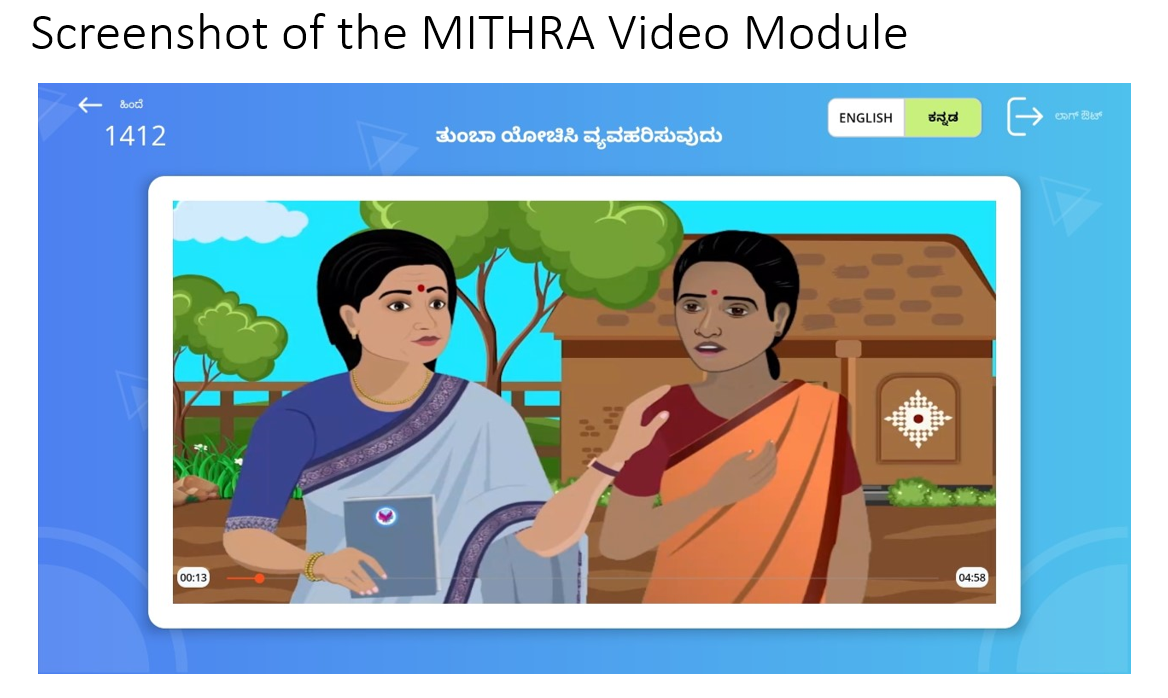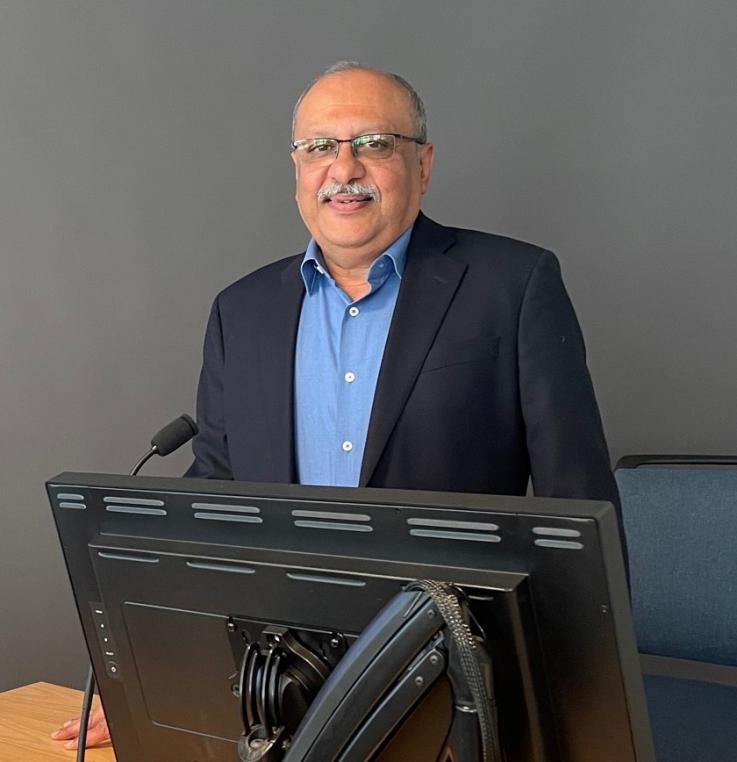The impact of gender inequity is felt within women’s mental health. India ranks 127th out of 146 countries on the gender gap index (Global Gender Gap Report 2023), and 142th in the “health & survival” sub-index. The National Family Health Survey (NFHS 5), 2019-21, found that only 32% of women had contact with any health care worker and one in 10 women in rural India have common mental disorders. To address this inequity, or treat a person’s mental health, treatment must be specific to a population’s resources, availability of mental health professionals, and the culture.
UWGMH works towards reducing the burden of mental disorders in low resource settings through evidence-based research, training, education, and advocacy. To help us understand the history of this disparity in India, and discuss his research on closing this gap, the UW Consortium for Global Mental Health (UWGMH) invited Dr. Krishnamachari Srinivasan to present on his research projects with interventions he’s developed that work to reduce depression, stigma, and domestic violence and work to build equity for women in rural India. Dr. Srinivasan’s research has shown success in strategies to close the gap on gender inequity in global mental health in India. He took the time to talk to us so we can learn from his successes as we continue to research and develop mental health interventions.
Dr. Amritha Bhat, a research partner of Dr. Srinivasan’s and a member of UW Consortium for Global Mental Health, describes his work over the past several decades as "focused on improving access to mental health care by collaborating with primary care and community-based organizations.” She says that Srinivasan “has been instrumental in implementing interventions that range from collaborative care for common mental disorders, to interventions to improve the wellbeing of women experiencing interpersonal violence.”
A sketch of gender inequity in India now
Women’s autonomy and agency in decision making is at the core of gender disparity. In his lecture Dr. Srinivasan shared that when surveyed only 57% of men agree that women should have equal or greater say in household decisions, 42% of women are allowed to travel alone to health facilities outside their village and just 51% of women of reproductive age participate in household decision making. Most women who earn cash for their labor make their decisions jointly with other members of her household (85%).
The Indian government has launched several programs to address the gender inequity gap, that include economic empowerment of women and programs to stop female feticide and educate daughters. These programs have resulted in some improvement, along with the modest improvements that are listed in overall equity that are listed in the first paragraph, India is now 26th out of 146 countries in educational attainment for women, an 81 point leap since 2022, and 59th in political empowerment, an 11 point dip since 2022, and a plummet since 2020 when they ranked 18th .
The concept of individual autonomy is not helpful in contributing to our understanding of empowering women within the collectivist culture of India and Southeast Asia. For example, women with closer ties to their birth family are more likely to have autonomy and utilization of maternal health care, so familial ties strengthen autonomy. To challenge male/female power dynamics in the collectivist culture of India, Srinivasan suggests it is more useful to support avenues to increase women’s agency to exercise choices within the big kin networks that are used to navigate all choices, rather than focusing on her making independent choices.
Gender inequity and mental health
Studies on Greek immigrant populations in London, England found that collectivist culture is linked to more mental illness stigmatization than individually oriented cultures and stigma is associated with suicidal ideation. Srinivasan linked this finding to India’s high suicide rates. In Dr. Srinivasan’s HOPE Study, they found that a one-point increase on the ISMI scale—a measure of Internalized stigma—triples risk of suicidal ideation. India has one of the highest rates of suicide mortality rates, for the overall population, in SE Asia (16.3/100,000) and ranks 3rd in female suicide rates globally.
Gender-centric mental health interventions
To address both the treatment and gender gap for women in rural India, gender-centric mental health interventions are needed. Dr. Srinivasan advocates for interventions to:
- Reduce the treatment barrier for women
- Increase women’s empowerment and her choices to seek treatment
- Improve mental health literacy
- Reduce stigma and use a destigmatizing approach to intervention
- Sensitize health workers at all levels to the mental health impacts of gender discrimination
Dr. Srinivasan proposes three possible approaches for addressing these gendered barriers to mental health care:
1. Integrating mental health components into women’s economic empowerment through the national model of women’s self-help groups in India
Recently researchers have begun to test self-help groups as a platform for health interventions. Self-help groups for economic empowerment are widespread in India with 90 million women as members in local groups. Delivering mental health interventions in such groups has the potential to reduce several treatment barriers. The groups meet very regularly, and there are very low rates of drop out and attrition. These are local groups, so women don’t have to travel long distances, or take time off from work, and these groups often meet in the evening hours when they are done with household work.
The groups can also deliver culturally sensitive interventions using a bottom-up approach and local knowledge to tune interventions. This setting also has the potential to reduce mental illness related stigma and discrimination since women already know one another and the situations in their households.
2. Integrating mental health into community-based organizations using trained lay health workers
This approach is sometimes referred to as “task shifting” or “task sharing” wherein mental health services normally delivered by mental health professionals are shifted to people with less specialized mental health training. Task shifting was first used to meet the needs of HIV/AIDS treatment in Africa, and the utility of this approach has since been recognized in several other medical fields. Task shifting has been found to be both an effective and cost saving treatment in a study of common mental disorders in India. And even treatment of schizophrenia by lay health workers supervised by mental health specialists has been found to be acceptable and feasible in India.
3. Use digital technologies to deliver mental health interventions.
Digital interventions provide several advantages, they can be lower cost to administer, don’t require onsite mental health experts, can bring interventions close to home without need to travel long distances, and can prevent stigmatization for seeking out mental health support. Smartphones are often shared family resources, knowing this Drs. Srinivasan and Bhat recently completed a pilot study assessing the feasibility and acceptability of a multi-user app, to be used on tablets with adaptations for digital illiteracy. The app delivers mental health screening and modules of the Healthy Activity Program in a self-administered, non-encounter, digital intervention, for women with depression in self-help groups. The effectiveness of low intensity, brief interventions, and self-managing mild to moderate depression has been well-proven.
The UW Consortium for Global Mental Health looks forward to seeing the outcomes of Dr. Srinivasan and Dr. Bhat’s study with the self-help groups, as well as the outcomes of a program to reduce domestic violence and alcohol consumption by male partners using behavioral couples therapy and motivational interviewing. We will be watching this work; it has the potential to improve the lives of so many women in India.
For more about his research projects watch the recording of this lecture with Dr. Srinivasan.

